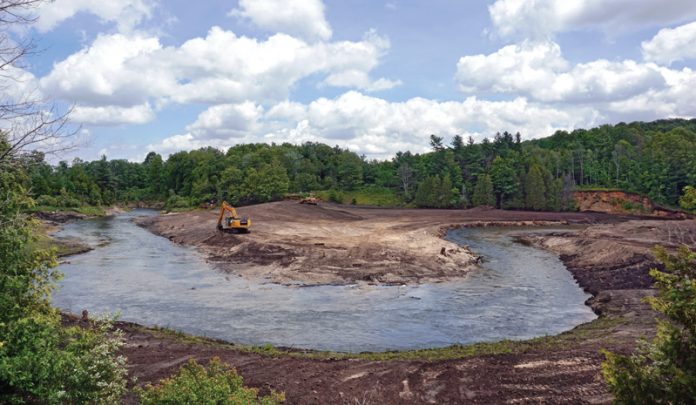
While December typically is a dormant time for northern Michigan landscapes, dynamic changes are unfolding along the banks of the Boardman River in Grand Traverse County. The 123-year-old Boardman Dam is being torn down, returning another segment of the popular trout stream’s natural flow after more than a century.
The Boardman is one of four dams being eliminated or modified in a multiyear plan that began changing the landscape in 2013 when Brown Bridge Dam was removed, 12 miles upstream. That restored 2.8 miles to its former free-flowing state and opened miles of river for fish passage to its headwaters in Kalkaska County. The river system includes 130 miles of stream with tributaries. It is one of the top 10 trout streams in the state.
“This part (Boardman Dam) will most likely be done by December, with restoration components in spring. The idea is to get this wrapped up,” said Frank Dituri, an ecologist with the Grand Traverse Band of Ottawa and Chippewa Indians and implementation team chairman for the multiagency project. The partners include the Michigan DNR, U.S. Fish and Wildlife Service, city of Traverse City, Grand Traverse County, Traverse City Light and Power, and Michigan Hydro Relicensing Coalition.
“The restorative process of Mother Earth is absolutely amazing.”
— Frank Dituri
What is taking place has been called “the most comprehensive dam removal and watershed restoration project in Michigan’s history,” according to DNR staffers. All four dams were located within 20 miles of the river mouth at West Grand Traverse Bay.
Sabin Dam, a mile downstream from Boardman, is next in 2018. Five miles further downstream in Traverse City, the Union Street Dam will be modified for selective fish passage. It will stay in place to keep sea lamprey out of the river.
Riverbanks upstream of Brown Bridge now are lush with growth and frequented by birds and mammals, according to Dituri. All of it was underwater prior to dam removal in 2013. River velocity has increased and washed away tons of silt, exposing historic gravel beds for spawning trout. Water temperatures now are cooler and better for native brook trout. The Boardman historically was a cold-water river system, but the impoundment behind the dam unnaturally warmed the water.
“The restorative process of Mother Earth is absolutely amazing,” Dituri said of the change being seen. “The bottomlands (formerly submerged under the impoundment) are covered in emerald green, and most species coming are native plants. We’ve planted 18,000 trees in the last few years, and the stands of poplar are so thick you can’t walk through them.

“The mayflies, stoneflies and caddisflies are back in the river in strong numbers,” Dituri continued. “And the fishermen say they enjoy (catching) 50 percent brook trout and 50 percent brown trout. That would have been 80 percent brown trout and 20 percent brook trout, plus pike bass and bluegill (before). We see signs of beaver, fox, coyote and bear. The corridor is really alive.”
Paddlers also are enjoying the changes; an additional 13 miles of unobstructed water will be opened once Boardman and Sabin dams are gone. That will elevate the Boardman even further as a paddling destination.
“You can have unimpeded passage from the headwaters down,” Dituri said. “People will see more fast water, including intermittent rapids from Boardman (Dam) to Sabine. It’s the steepest section of river geologically. It won’t be Class 4 rapids, but will be exciting Class 2.”
That’s another reason to be excited about this monumental river restoration project. That this beautiful river will run free again is what Pure Michigan is about.
Howard Meyerson is the managing editor for Michigan BLUE Magazine.







Facebook Comments